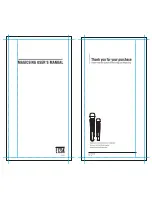
OM-172 324 Page 17
7-2.
Teach Points Explained
The teach mode allows the user to create
custom pulse MIG welding programs. The
teach mode has 15 teach points. At each
teach point, the user can adjust four parame-
ters: peak amperage (ApK), background am-
perage (AbK), pulses per second (PPS), and
pulse width in milliseconds (PWms) to shape
the pulse waveform of the weld output.
Wire feed speed teach points can range from
the minimum to the maximum wire feed
speed of the feeder. When using a standard
speed motor, wire feed speed teach points
typically range from 50 to 750 ipm. The feeder
uses pulse parameters at teach points to es-
tablish the pulse parameters at any wire feed
speed setting.
Below the wire feed speed of the lowest teach
point, and above the wire feed speed of the
highest teach point, the unit may limit wire
feed speed settings in pulse MIG to maintain
all pulse parameters within the capability of
the unit.
Pulse MIG programs made by the manufac-
turer have pulse waveform information en-
tered for all 15 teach points. The operator can
relocate and modify the setting of one, or any
number of the 15 teach points if the factory
set information is not appropriate for a specif-
ic application.
After the parameters for each teach point are
established, an arc must be struck and main-
tained for at least 5 seconds in teach mode.
This allows the wire feeder to learn the arc
voltage length associated with the taught
pulse parameters. To ensure a proper arc
length reading, electrode stick-out must be
carefully maintained.
The taught arc length represents a Trim (arc
length) setting of 50. Increasing the value of
Trim, increases the actual arc length. Like-
wise, decreasing the value of Trim will
decrease actual arc length.
In the Pulse mode, the unit does not maintain
a constant arc length with variations in elec-
trode stick-out. In the Adaptive Pulse mode,
the unit adjusts pulse frequency to maintain a
constant arc length regardless of variations
in electrode stick-out.
Proceed to next section to teach a pulse MIG
program.
150
180
210
240
270
300
330
360
370
420
450
480
510
540
565
ApK
10
20
30
40
50
60
70
80
90
100
110
120
130
140
150
AbK
30
55
80
105
130
160
185
210
235
260
290
315
340
365
400
PPS
1
3
5
PWms
2
4
780
750
700
650
600
550
500
450
400
350
300
250
200
150
100
50
ApK
AbK
PPS
PWms
Setting For 425 IPM With
All Teach Points Set At
Example Of A Synergic
IPM
50 IPM Increments
Figure 7-2. Typical Teach Point Settings And Resulting Synergic Setting
Summary of Contents for Robotic Interface II
Page 2: ......
Page 57: ...OM 172 324 Page 51 SD 171 360 A...
Page 58: ...OM 172 324 Page 52 Figure 12 2 Circuit Diagram For Microprocessor Board PC1...
Page 59: ...OM 172 324 Page 53 SD 161 039 A...
Page 60: ...OM 172 324 Page 54 Figure 12 3 Circuit Diagram For Motor Board PC3...
Page 61: ...OM 172 324 Page 55 SD 083 388 B...
Page 62: ...OM 172 324 Page 56 Figure 12 4 Circuit Diagram For Customer Interface Board PC4...
Page 63: ...OM 172 324 Page 57 SD 166 275...
Page 64: ...OM 172 324 Page 58 Figure 12 5 Circuit Diagram For Interface Board PC5...
Page 65: ...OM 172 324 Page 59 SD 165 466...
Page 66: ...OM 172 324 Page 60 Figure 12 6 Circuit Diagram For Filter Board PC6 SB 159 412...
Page 67: ...OM 172 324 Page 61 Figure 12 7 Circuit Diagram For Display Board PC7 SC 165 462 A...
Page 69: ...OM 172 324 Page 63 NOTES...
Page 78: ......
















































